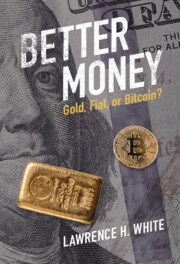Book contents
- Better Money
- Better Money
- Copyright page
- Dedication
- Contents
- Figures
- Acknowledgments
- Introduction
- 1 Markets and Governments in the History of Money
- 2 How a Gold Standard Works
- 3 Common Misconceptions about the Gold Standard
- 4 How a Fiat Standard Works
- 5 How a Bitcoin Standard Works
- 6 Comparing and Contrasting Gold and Bitcoin Standards
- References
- Index
2 - How a Gold Standard Works
Published online by Cambridge University Press: 16 March 2023
- Better Money
- Better Money
- Copyright page
- Dedication
- Contents
- Figures
- Acknowledgments
- Introduction
- 1 Markets and Governments in the History of Money
- 2 How a Gold Standard Works
- 3 Common Misconceptions about the Gold Standard
- 4 How a Fiat Standard Works
- 5 How a Bitcoin Standard Works
- 6 Comparing and Contrasting Gold and Bitcoin Standards
- References
- Index
Summary
Chapter 2. A “gold standard” means a monetary system in which a defined mass of gold coin or bullion is the unit of account in which prices are posted and accounts kept, and gold coin or bullion is the medium of redemption that ordinary currency and bank accounts promise to pay. Once modern banking developed, the vast majority of money was held and spent in the form of banknotes and deposit transfers, not coins. A monometallic gold standard with bank-issued money avoids problems created by legally imposing bimetallism. A series of supply-and-demand diagrams explains how a gold standard works to determine the quantity and purchasing power of money. The diagrams show how market forces stabilize the purchasing power of gold in response to various shifts in money demand and supply. A major gold discovery can change the purchasing power of gold by altering the supply from mining, but large discoveries were historically rare. The resource costs of a gold standard, the expenditure of labor and capital to extract and coin gold, have been over-estimated by economists who assume away the role of the banking system in economizing on the amount of gold used for transactions.
- Type
- Chapter
- Information
- Better MoneyGold, Fiat, or Bitcoin?, pp. 39 - 75Publisher: Cambridge University PressPrint publication year: 2023



